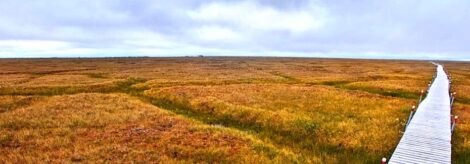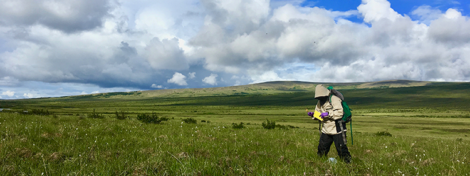Advancing the predictive power of Earth system models through understanding of the structure and function of Arctic terrestrial ecosystems
Project website | Overview brochure PDF | Podcast | Feature article
| Podcast | Feature article
Principal investigator: Colleen M. Iversen
An important challenge for Earth system models (ESMs) is to accurately represent land surface and subsurface processes and their complex interactions. This is true for all regions of the world, but is especially important for high-latitude Arctic ecosystems that are characterized by ice-rich landscapes where topography, hydrology, vegetation, and biogeochemistry are inextricably linked. To address this challenge, the Environmental System Science (ESS) program within the Department of Energy’s (DOE) Biological and Environmental Research (BER) program is supporting a Next-Generation Ecosystem Experiments project in the Arctic (NGEE Arctic).

Landscapes in Transition. A mechanistic understanding of what controls the coupled nature of hydrology, biogeochemistry, and vegetation dynamics is needed for system-wide understanding and prediction of a range of tundra ecosystems underlain by continuous and discontinuous permafrost. NGEE Arctic research activities are designed to identify and quantify the mechanisms underlying processes.
The NGEE approach seeks to improve the representation of critical environmental processes in ESMs by focusing on systems that are globally important, climatically sensitive, and understudied or inadequately represented in models. In this approach, modeling and process research are closely and iteratively connected so that model structure and computational requirements are considered in the development of process studies whose outcomes, in turn, are designed to directly inform, challenge, and improve the predictive power of numerical models.
Ultimately, the NGEE Arctic project is developing a process-rich model, extending from the bedrock to the interface between the vegetative canopy and the atmosphere, in which the evolution of Arctic ecosystems can be modeled at the scale of a high-resolution ESM grid cell (~1 km).
Key Science Questions
The NGEE Arctic project seeks to understand how surface and subsurface processes and properties are interconnected across permafrost-dominated tundra ecosystems. Related research experiments and modeling efforts on Alaska’s North Slope and Seward Peninsula are designed to answer the following questions:
- How does the structure and organization of the landscape control the storage and flux of carbon and nutrients in a changing climate?
- What will control rates of carbon dioxide and methane fluxes across a range of environmental conditions?
- How do plant functional traits change across environmental gradients, and what are the consequences for carbon, water, and nutrient fluxes?
- What determines shrub distribution across the tundra landscape, and how will shrub distribution and atmospheric feedbacks change in the future?
- Where, when, and why will the Arctic become wetter or drier, and what are the pan-Arctic implications?
- What controls the vulnerability of Arctic ecosystems to disturbance, and how do disturbances alter the structure and function of these ecosystems?

Permafrost Landscapes. Degradation of ice-rich permafrost causes subsidence and increased variability in topography across the Arctic landscape. Associated changes in hydrology, vegetation, and biogeochemistry create “hot spots” (i.e., locations within an ecosystem that exert a disproportionately large influence on the flow and processing of nutrients) for carbon dioxide and methane fluxes.
Integration Across Scales
Variation in landscape structure and organization—including ridges, valleys, and watershed basins—provide the organizing framework for integrating process studies. Multiscale research activities organized around these components are designed to help determine whether the Arctic is, or in the future will become, a negative or positive feedback to anthropogenically forced climate change. These activities include landscape heterogeneity, soil biogeochemistry, plant traits, shrub dynamics, watershed hydrology, and disturbance.
Landscape heterogeneity considers how vegetation, biogeochemistry, and hydrology are influenced by regional landforms such as ridges, valleys, and drainage basins. Variation in landscape form and function are simplified for input into models while still retaining fine-scale features with the strongest influence on climate feedbacks.
Soil biogeochemistry focuses on the influence of temperature, moisture, and nutrients on microbial dynamics and soil organic matter decomposition. Understanding controls over carbon dioxide and methane fluxes across a range of environmental conditions has been critical for improving predictions of net carbon exchange in Arctic systems.
Plant traits provide an important link among plant communities, tundra biogeochemistry, and biophysical feedbacks to the atmosphere. Improved understanding of tundra plant traits, above- and belowground, have led to new approaches for scaling plant function from leaf to landscape using remotely sensed data and models.
Shrub dynamics focuses on advancing capabilities to determine shrub distributions and predict their impacts on climate, now and in the future. The development of dynamic tundra vegetation models, including new shrub and moss functional types, has facilitated process-rich simulations over the 21st century and the identification of structural and parameter priorities for dynamic predictions.
Watershed hydrology determines the spatial distribution and temporal dynamics of soil saturation and inundation and, in turn, surface and subsurface hydrological and biogeochemical cycling and local- to regional-scale energy balance. Observations have informed key model improvements in prediction of past, present, and future distributions of snow, soil moisture and inundation, and surface and subsurface water flow across the Arctic landscape.
Disturbances such as wildfire, thermokarst, and thermal erosion are expected to increase in frequency and magnitude over the coming decades due to a warmer climate and the intensification of human activities in the Arctic and have the potential to cause profound changes by disrupting processes that regulate climate feedbacks. Observations and model simulations have targeted knowledge gaps and interactions among multiple forms of disturbance.
Connecting Observations to Models

Climate Feedbacks. The distribution and dynamics of vegetation across Alaska’s Seward Peninsula reflect the interplay of permafrost, hydrology, and topography, which in turn has a critical influence on the carbon and energy budget of tundra landscapes.
This comprehensive suite of NGEE Arctic process studies and observations is being strongly linked to model development and application requirements for improving process representation, initializing multiscale model domains, calibrating models, and evaluating model predictions. A fundamental challenge for the NGEE Arctic modeling activity is to relate new process knowledge gained at fine and intermediate spatial scales to states and fluxes relevant for integration in ESMs. Consequently, a nested hierarchy of models is being engaged at fine, intermediate, and global scales, connecting process studies to models and models to each other in a quantitative upscaling and downscaling framework.
Leveraging Investments
Led by Oak Ridge National Laboratory, the NGEE Arctic project’s collaborative effort includes scientists at Brookhaven National Laboratory, Lawrence Berkeley National Laboratory, Los Alamos National Laboratory, University of Alaska Fairbanks, and partners at universities and other state and federal agencies. Furthermore, the NGEE Arctic project is grateful to several Native Corporations for their guidance and for allowing the team to conduct research on the traditional homelands of the Iñupiat: UIC Science, Bering Straits Native Corporation, Council Native Corporation, Mary’s Igloo Native Corporation, and the Sitnasuak Native Corporation.

Climate Feedbacks. Changes in vegetation, especially an increased abundance of tall shrubs, also is a strong determinant of snow depth distribution (inset), which impacts soil temperatures and discharge of water to streams and rivers.
In addition to ESS, other BER programs involved in the NGEE Arctic project include:
- Atmospheric Radiation Measurement (ARM) user facility
- Atmospheric System Research program
- Earth and Environmental Systems Modeling, including the Energy Exascale Earth System Model (E3SM) project and International Land Model Benchmarking project (ILAMB)
- Environmental Molecular Sciences Laboratory
- Genomic Science program
NGEE Arctic also is affiliated with other federal and international monitoring projects, including NASA’s Arctic-Boreal Vulnerability Experiment (ABoVE).
BER provides research funding to leverage the NGEE investment through regular Funding Opportunity Announcements posted at grants.gov.
A Culture of Collaboration
The NGEE Arctic project is committed to the development of a culture of safety, inclusion, and trust as the foundation for cross-disciplinary science (Iversen et al. 2020). Summarized, the project’s values promote safe and harassment-free work environments, respect for local culture and knowledge of the environment in areas and communities where researchers are guests, and collaboration and open science. All NGEE Arctic data generated from observations, experiments, and models are available at ngee-arctic.ornl.gov.
